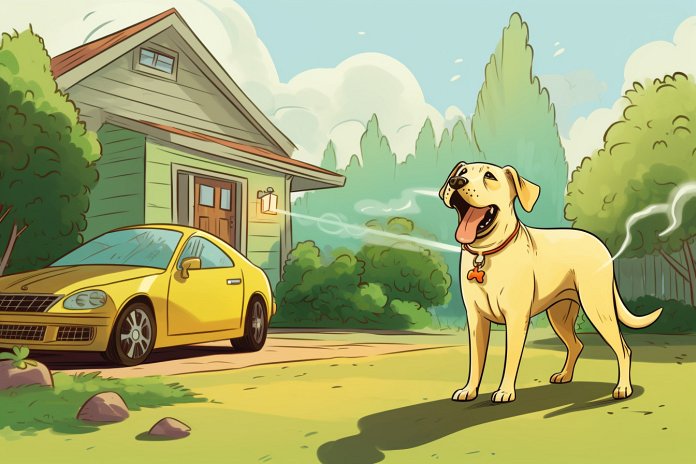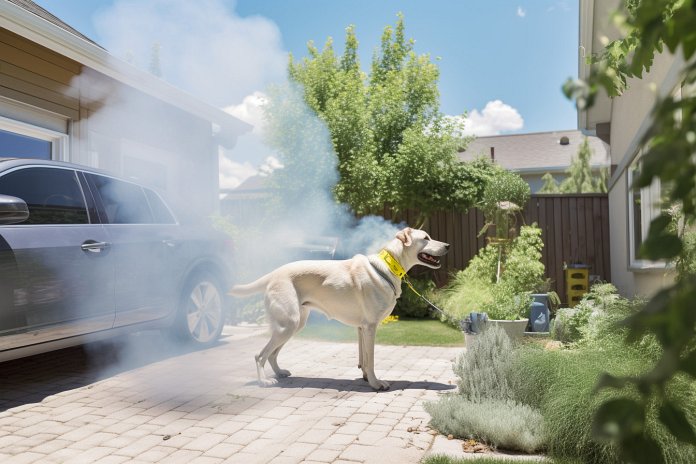
Dogs are more susceptible to carbon monoxide poisoning than humans, but they cannot detect it like other things. However, if your dog starts acting strangely, it could be a sign of carbon monoxide in your home. It is important to note that you should not send your dog into a potentially dangerous area to test for carbon monoxide. Instead, watch for signs and symptoms of carbon monoxide exposure in your dog.
Signs Your Dog Has Been Exposed to CO
Similar to humans, dogs may show signs of weakness, lethargy, and sleepiness if they have been exposed to carbon monoxide. Check their gums for redness, splotchy or itchy skin, and observe their coordination and reflexes. Gastrointestinal irregularities may also occur. If your dog exhibits these symptoms, it is best to get them out of the house immediately.
Body Language
Dogs experiencing carbon monoxide poisoning may exhibit signs such as shaking, weakness, raspy panting, lack of focus, head bobbing, dilated pupils, whale eye, and sleepiness. Other signs may include stumbling, vomiting, bowel issues, disorientation, confusion, unconsciousness, sleepiness, itchy skin, and red gums.
The History of Carbon Monoxide Poisoning in Dogs
Carbon monoxide is a dangerous byproduct of combustion that can cause poisoning in homes and buildings. Common causes include malfunctioning household appliances, running car engines in enclosed spaces, burning charcoal, and blocked chimneys or flues.
Science Behind Carbon Monoxide Poisoning in Dogs
Carbon monoxide is a colorless, tasteless, and odorless gas that displaces oxygen in the blood, depriving the body of the oxygen it needs. Dogs can be affected by carbon monoxide more quickly and severely than humans. Breathing in carbon monoxide can cause unconsciousness and suffocation.
Training Your Dog to Deal with CO Poisoning Treatment
It is important to train your dog to be comfortable with vet visits, as treatment for carbon monoxide poisoning may be necessary. After exposure to carbon monoxide, your dog may require several weeks of treatment. During this time, limit their activity and gradually reintroduce short walks. Monitor their nervous system and response times, and consider engaging them in doggy puzzle games.
“Dogs can’t detect carbon monoxide, but they are more susceptible to its effects. Recognizing the signs of carbon monoxide poisoning in your pet can potentially save both your lives.”

Tips & Things to Know
1️⃣ Keep an eye out for symptoms of carbon monoxide poisoning in your dog such as weakness, lethargy, sleepiness, redness in the gums, splotchy or itchy skin, irregular coordination and reflexes, and gastrointestinal issues. If you notice these signs, remove your dog from the house immediately.
2️⃣ Carbon monoxide is a dangerous, colorless, tasteless, and odorless gas that displaces oxygen in the blood, potentially causing unconsciousness and suffocation. It is produced from malfunctioning household appliances, running car engines in enclosed spaces, burning charcoal, and blocked chimneys or flues. Dogs are more susceptible to carbon monoxide poisoning than humans, so it’s crucial to ensure your home is well ventilated and your appliances are in good working order.
3️⃣ After an exposure to carbon monoxide, your dog may need several weeks of treatment. During this time, it’s important to limit their physical activity and gradually reintroduce short walks. Monitor their nervous system and response times, and consider engaging them in doggy puzzle games to stimulate their brain. It’s also beneficial to train your dog to be comfortable with vet visits in case of emergencies like carbon monoxide poisoning.
Frequently Asked Questions, Answered ✅
1. How can I tell if my dog has been exposed to carbon monoxide?
– Signs to look out for include weakness, lethargy, sleepiness, red gums, splotchy or itchy skin, and gastrointestinal irregularities.
2. What body language should I watch for in my dog if I suspect carbon monoxide poisoning?
– Dogs may exhibit shaking, weakness, raspy panting, lack of focus, head bobbing, dilated pupils, whale eye, stumbling, vomiting, bowel issues, disorientation, confusion, unconsciousness, sleepiness, itchy skin, and red gums.
3. What are common causes of carbon monoxide poisoning in dogs?
– Malfunctioning household appliances, running car engines in enclosed spaces, burning charcoal, and blocked chimneys or flues are common causes.
4. How does carbon monoxide affect dogs differently than humans?
– Dogs can be affected more quickly and severely than humans. Breathing in carbon monoxide can cause unconsciousness and suffocation.
5. How should I train my dog to deal with carbon monoxide poisoning treatment?
– It is important to train your dog to be comfortable with vet visits, as treatment for carbon monoxide poisoning may be necessary. Limit their activity, gradually reintroduce short walks, monitor their nervous system and response times, and engage them in doggy puzzle games.